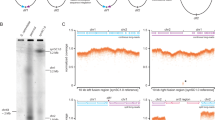Summary
Following transduction of exponentially growing cultures of Escherichia coli with phage P1, cells with recombinant phenotype begin to increase in number after an initial lag of about one generation time. We show that transductants for markers located at different positions on the chromosome begin to increse at different times, in reverse order to that in which they are replicated. The period over which this happens is equal in duration to the time taken to replicate the chromosome and we have used this relationship to calculate the C-period of E. coli K12 growing at 30°C. We exclude transduction-induced filamentation as the cause of the initial lag and suggest that the lag may result from the way in which donor DNA is inherited.
Similar content being viewed by others
References
Begg KJ, Donachie WD (1978) Changes in cell size and shape in thymine requiring Escherichia coli associated with growth in low concentrations of thymine. J Bacteriol 133:452–458
Bender RA, Sambucetti LC (1983) Recombination induced suppression of cell division following P1-mediated generalized transduction in Klebsiella aerogenes. Mol Gen Genet 189:263–268
Cooper S, Helmstetter CE (1968) Chromosome replication and the division cycle of Escherichia coli B/r. J Mol Biol 31:519–540
Donachie WD (1969) Control of cell division in Escherichia coli: Experiments with thymine starvation. J Bacteriol 100:260–268
Ebel-Tsipis J, Fox MS, Botstein D (1972) Generalized transduction by bacteriophage P22 in Salmonella typhimurium II. Mechanism of integration of transducing DNA. J Mol Biol 71:449–469
Hanks M (1986) Aspects of P1 mediated generalized transduction. Ph D thesis, Edinburgh University
Hayes W (1957) The kinetics of the mating process in E. coli. J Gen Microbiol 16:97–119
Helling RB (1967) The effect of arabinose-specific enzyme synthesis on recombination in the arabinose genes of Escherichia coli. Genetics 57:665–675
Legros M, Kepes A (1985) One step microassay of DNA in procaryotes. Anal Biochem 147:497–502
MacKay DJ, Bode VC (1976) Events in lambda injection between phage adsorption and DNA entry. Virology 72:154–166
Masters M (1970) Origin and direction of replication of the chromosome of E. coli. Proc Natl Acad Sci USA 65:601–608
Masters M (1977) The frequency of P1 transduction of the genes of Escherichia coli as a function of chromosomal position: Preferential transduction of the origin of replication. Mol Gen Genet 155:197–202
Sandri RM, Berger H (1980) Bacteriophage P1-mediated generalized transduction in Escherichia coli: Fate of transduced DNA in Rec+ and RecA- recipients. Virology 106:14–29
Siddiqi O, Fox MS (1973) Integration of donor DNA in bacterial conjugation. J Mol Biol 77:101–123
Tomizawa J (1960) Genetic structure of recombinant chromosomes formed after mating in Escherichia coli K12. Proc Natl Acad Sci USA 46:91–101
Zaritsky A, Pritchard RH (1971) Replication time of the chromosome in thymineless mutants of Escherichia coli. J Mol Biol 60:65–74
Author information
Authors and Affiliations
Additional information
Communicated by D.J. Finnegan
Rights and permissions
About this article
Cite this article
Hanks, M.C., Masters, M. Transductional analysis of chromosome replication time. Molec Gen Genet 210, 288–293 (1987). https://doi.org/10.1007/BF00325696
Received:
Issue Date:
DOI: https://doi.org/10.1007/BF00325696




